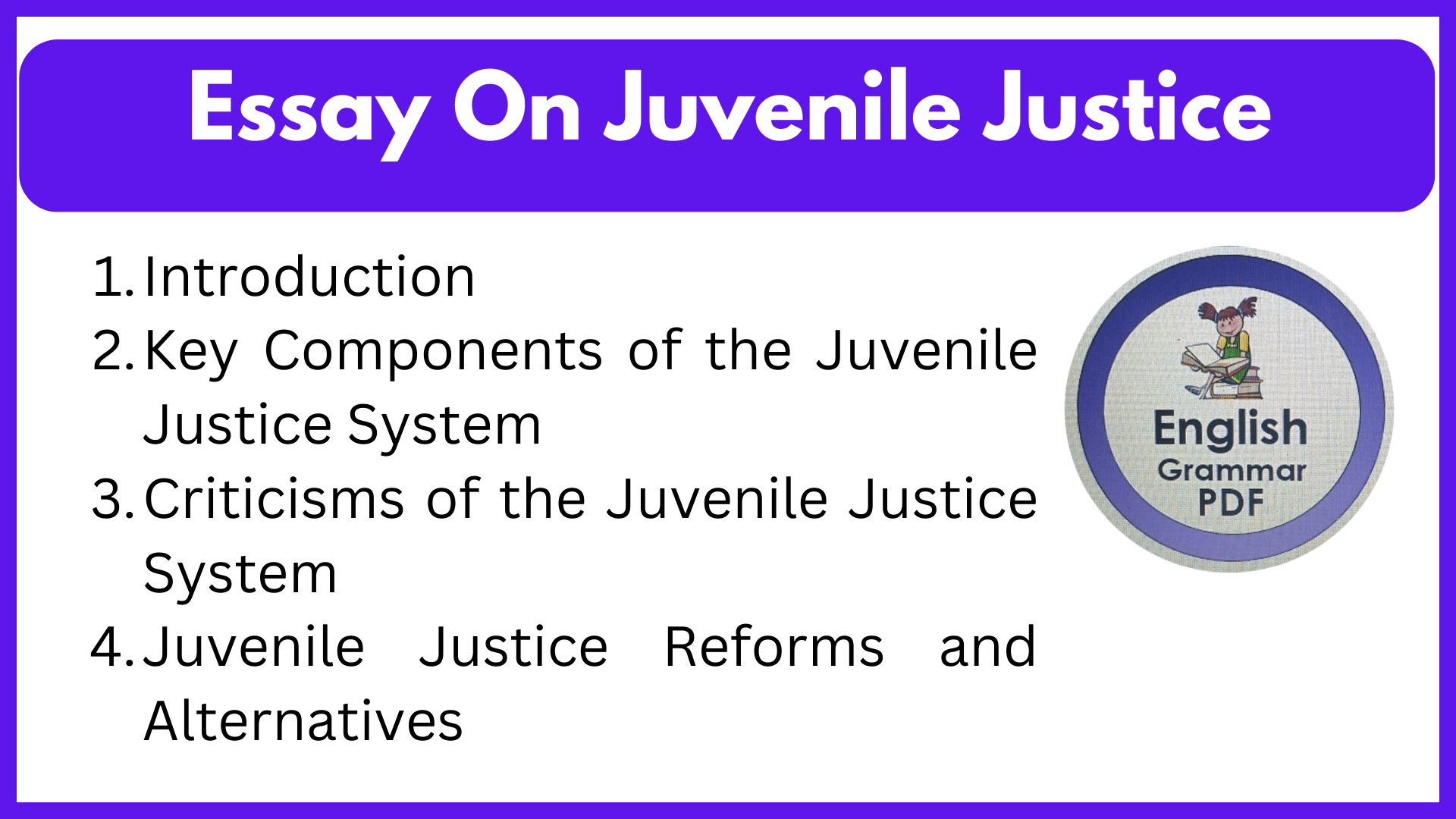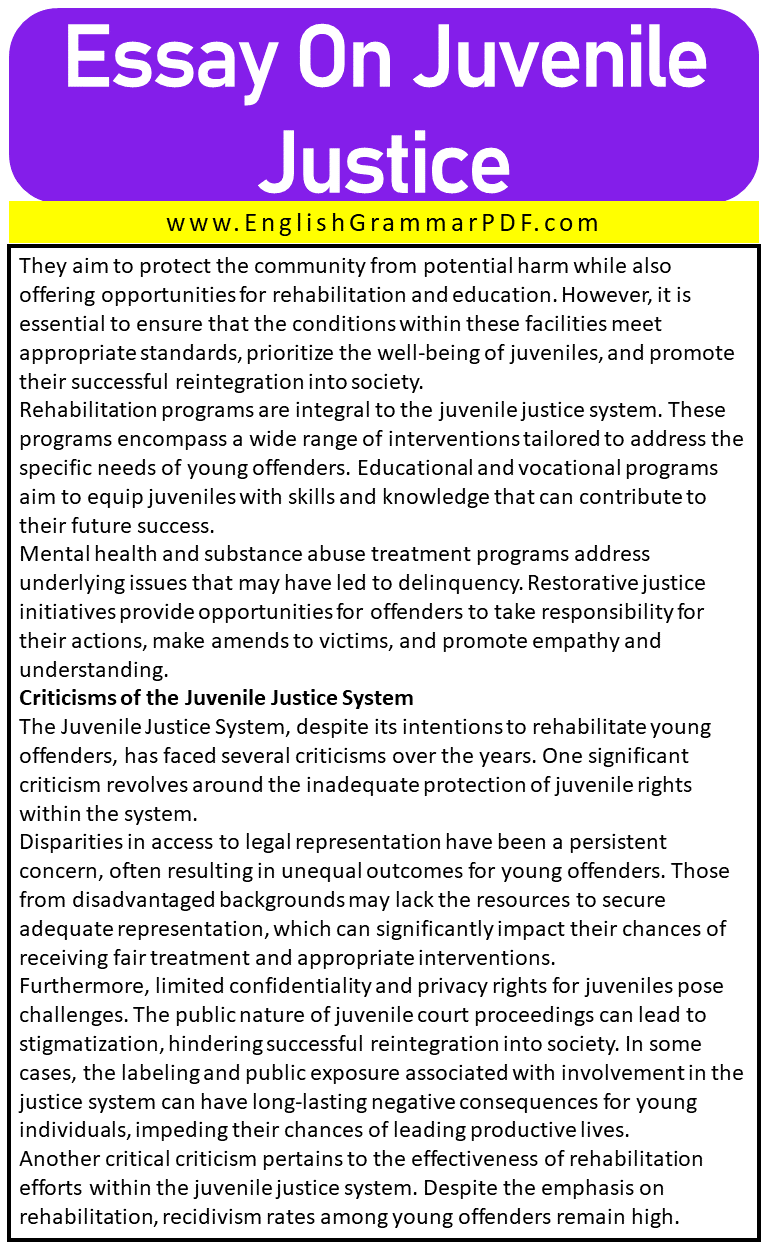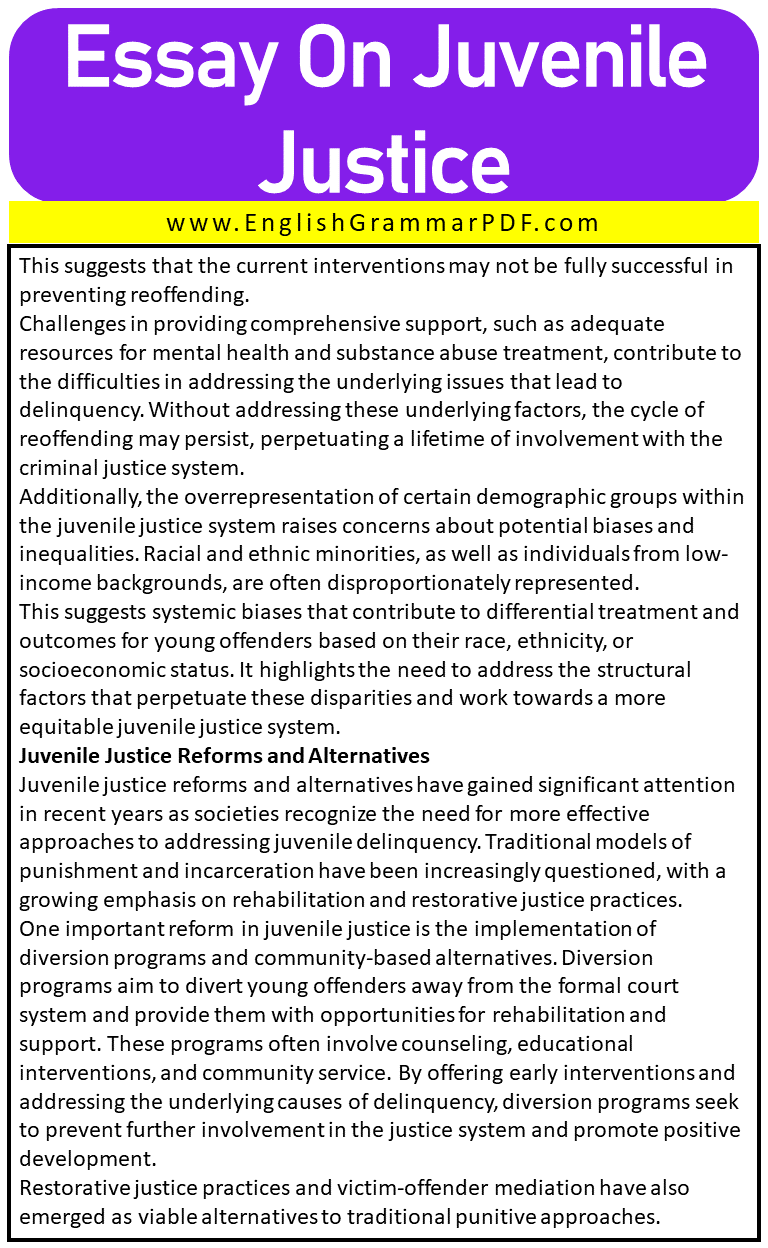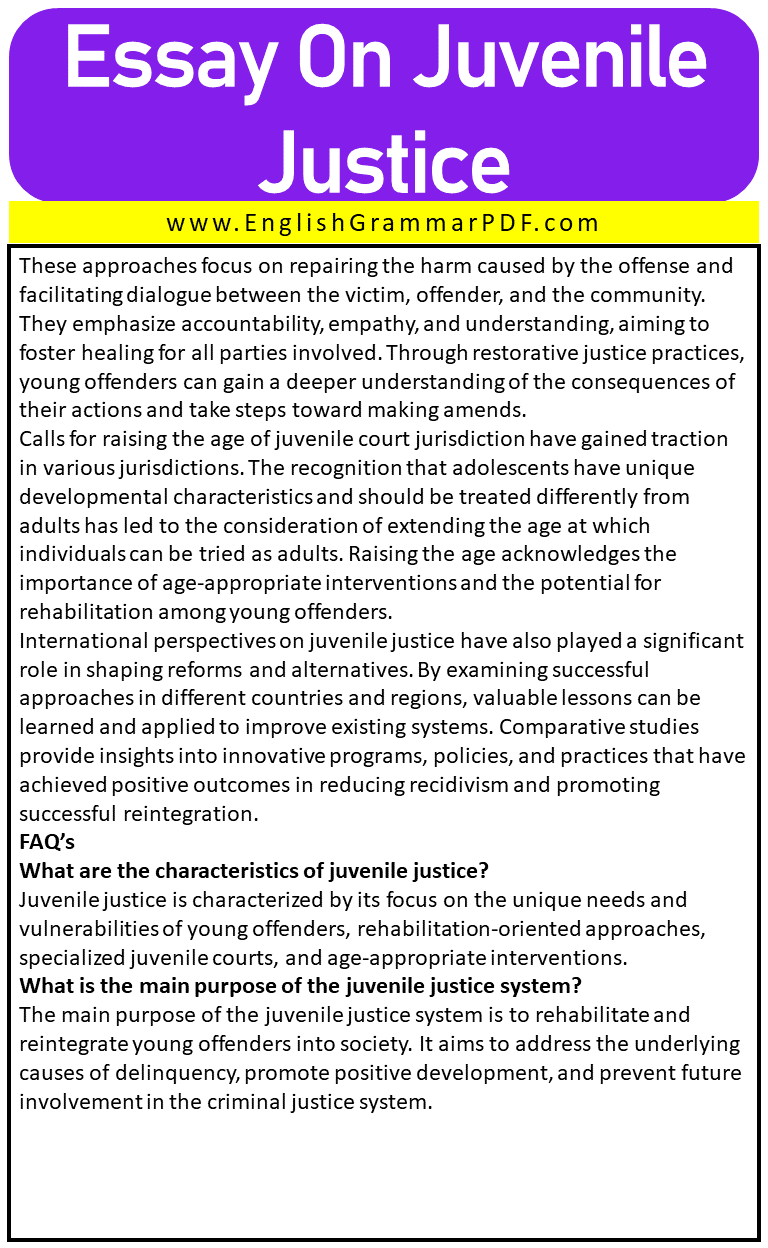Essay On Juvenile Justice
Outline of essay:
- Introduction
- Key Components of the Juvenile Justice System
- Criticisms of the Juvenile Justice System
- Juvenile Justice Reforms and Alternatives
Introduction
Juvenile justice refers to the legal system that deals with individuals who commit offenses while they are still minors. It aims to address delinquency among young people and provide them with opportunities for rehabilitation and reintegration into society. The importance of juvenile justice lies in its potential to prevent youth from continuing a life of crime and to foster their positive development. This essay will explore the key components of the juvenile justice system, its evolution, and the ongoing debate surrounding its effectiveness in rehabilitating young offenders.
Key Components of the Juvenile Justice System
The juvenile justice system comprises several key components that work together to address juvenile delinquency and promote rehabilitation. These components include the juvenile court system, juvenile detention facilities, and rehabilitation programs.
The juvenile court system plays a central role in the juvenile justice system. It is designed to handle cases involving young offenders and focuses on their unique needs and circumstances. Juvenile court judges are specially trained to understand the developmental differences of young people and make informed decisions regarding appropriate interventions and treatments.
They consider factors such as the offender’s age, background, and severity of the offense to determine the most suitable course of action. Juvenile court judges are responsible for ensuring fair treatment and due process rights for juvenile offenders, including the right to legal representation.
Juvenile detention facilities are another crucial component of the juvenile justice system. These facilities serve different purposes depending on the length of stay, ranging from short-term secure detention centers to long-term residential facilities. The primary goal of these facilities is to provide a safe and supportive environment for young offenders.
They aim to protect the community from potential harm while also offering opportunities for rehabilitation and education. However, it is essential to ensure that the conditions within these facilities meet appropriate standards, prioritize the well-being of juveniles, and promote their successful reintegration into society.
Rehabilitation programs are integral to the juvenile justice system. These programs encompass a wide range of interventions tailored to address the specific needs of young offenders. Educational and vocational programs aim to equip juveniles with skills and knowledge that can contribute to their future success.
Mental health and substance abuse treatment programs address underlying issues that may have led to delinquency. Restorative justice initiatives provide opportunities for offenders to take responsibility for their actions, make amends to victims, and promote empathy and understanding.
Criticisms of the Juvenile Justice System
The Juvenile Justice System, despite its intentions to rehabilitate young offenders, has faced several criticisms over the years. One significant criticism revolves around the inadequate protection of juvenile rights within the system.
Disparities in access to legal representation have been a persistent concern, often resulting in unequal outcomes for young offenders. Those from disadvantaged backgrounds may lack the resources to secure adequate representation, which can significantly impact their chances of receiving fair treatment and appropriate interventions.
Furthermore, limited confidentiality and privacy rights for juveniles pose challenges. The public nature of juvenile court proceedings can lead to stigmatization, hindering successful reintegration into society. In some cases, the labeling and public exposure associated with involvement in the justice system can have long-lasting negative consequences for young individuals, impeding their chances of leading productive lives.
Another critical criticism pertains to the effectiveness of rehabilitation efforts within the juvenile justice system. Despite the emphasis on rehabilitation, recidivism rates among young offenders remain high. This suggests that the current interventions may not be fully successful in preventing reoffending.
Challenges in providing comprehensive support, such as adequate resources for mental health and substance abuse treatment, contribute to the difficulties in addressing the underlying issues that lead to delinquency. Without addressing these underlying factors, the cycle of reoffending may persist, perpetuating a lifetime of involvement with the criminal justice system.
Additionally, the overrepresentation of certain demographic groups within the juvenile justice system raises concerns about potential biases and inequalities. Racial and ethnic minorities, as well as individuals from low-income backgrounds, are often disproportionately represented.
This suggests systemic biases that contribute to differential treatment and outcomes for young offenders based on their race, ethnicity, or socioeconomic status. It highlights the need to address the structural factors that perpetuate these disparities and work towards a more equitable juvenile justice system.
Juvenile Justice Reforms and Alternatives
Juvenile justice reforms and alternatives have gained significant attention in recent years as societies recognize the need for more effective approaches to addressing juvenile delinquency. Traditional models of punishment and incarceration have been increasingly questioned, with a growing emphasis on rehabilitation and restorative justice practices.
One important reform in juvenile justice is the implementation of diversion programs and community-based alternatives. Diversion programs aim to divert young offenders away from the formal court system and provide them with opportunities for rehabilitation and support. These programs often involve counseling, educational interventions, and community service. By offering early interventions and addressing the underlying causes of delinquency, diversion programs seek to prevent further involvement in the justice system and promote positive development.
Restorative justice practices and victim-offender mediation have also emerged as viable alternatives to traditional punitive approaches. These approaches focus on repairing the harm caused by the offense and facilitating dialogue between the victim, offender, and the community.
They emphasize accountability, empathy, and understanding, aiming to foster healing for all parties involved. Through restorative justice practices, young offenders can gain a deeper understanding of the consequences of their actions and take steps toward making amends.
Calls for raising the age of juvenile court jurisdiction have gained traction in various jurisdictions. The recognition that adolescents have unique developmental characteristics and should be treated differently from adults has led to the consideration of extending the age at which individuals can be tried as adults. Raising the age acknowledges the importance of age-appropriate interventions and the potential for rehabilitation among young offenders.
International perspectives on juvenile justice have also played a significant role in shaping reforms and alternatives. By examining successful approaches in different countries and regions, valuable lessons can be learned and applied to improve existing systems. Comparative studies provide insights into innovative programs, policies, and practices that have achieved positive outcomes in reducing recidivism and promoting successful reintegration.
FAQ’s
What are the characteristics of juvenile justice?
Juvenile justice is characterized by its focus on the unique needs and vulnerabilities of young offenders, rehabilitation-oriented approaches, specialized juvenile courts, and age-appropriate interventions.
What is the main purpose of the juvenile justice system?
The main purpose of the juvenile justice system is to rehabilitate and reintegrate young offenders into society. It aims to address the underlying causes of delinquency, promote positive development, and prevent future involvement in the criminal justice system.
Explore More Essays:
Download the PDF of the Essay:







